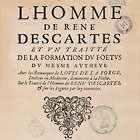Natural philosophy in the ancient collections of the BU Lettres and the Bibliothèque Saint Charles
Exhibition organized by the BU Lettres
Date:February 10 to March 13, 2014
Timetable:
Location:R. Llull Library
The ancient collection of the BU Lettres, kept in the Reserve, includes 5671 printed works from the 16thto19thcenturies in a wide variety of disciplines: geography, history, theology, social sciences, arts, general literature and linguistics, German, English, French, Romanesque, Classical and Slavic languages and literature.
"With this inscription, which adorns the pediment of the Academy, the school he founded in Athens, the Greek philosopher Plato hints at the historical link between philosophy and science, enabling us to understand what is meant by natural philosophy(philosophia naturali).

From antiquity to the end of the 16thcentury, the term science was synonymous with knowledge or study. When the subject of study was nature and the physical universe, the term natural philosophy was used. Developed from the 13thcentury onwards, and transmitted in all its variants until the end of the 16thcentury, natural philosophy covers a broad spectrum of disciplines: astronomy, physics, chemistry, biology, arithmetic, geometry, harmony, the theory of the elements, cosmology, mineralogy, botany and zoology. It is distinct from moral philosophy (morality and ethics), the theory of knowledge, psychology, sociology, politics and aesthetics.
Science and philosophy appeared at the same time, among the Greeks, over two and a half thousand years ago. For the Stoic and Epicurean philosophers, physics is, along with logic and ethics, one of the three parts of philosophy. Philosophy (first philosophy, later called metaphysics) represents the supreme science, that of "first principles and first causes" (Aristotle), while the other sciences (arithmetic, geometry, astronomy, physics and natural sciences) receive their foundation from it and are subordinate to it (hence the name second philosophy).
In the Middle Ages, philosophy (ethics, physics, logic) was the source of the liberal arts, which corresponded to the seven fundamental sciences (grammar, rhetoric, dialectics, music, arithmetic, geometry and astronomy). The chairs of natural philosophy established in the ancient universities created in the 13thcentury encompassed all the natural sciences, according to an academic corpus based on Aristotle's philosophy.
At the dawn of the modern age, Descartes still likened philosophy to "a tree, whose roots are metaphysics, whose trunk is physics and whose branches are all the other sciences, which can be reduced to three main ones: medicine, mechanics and morals. René Descartes began his career as a scientist, working in analysis, geometry and optics. Blaise Pascal made discoveries in mathematics and fluid mechanics.
The most important scientist of the time, Isaac Newton, along with Leibniz, invented differential and integral calculus. His bookPhilosophiaeNaturalis Principia Mathematica(1687), of which the BU Lettres owns the 1739 edition, was considered the model of scientific theory until the early 20thcentury. His prestige influenced many philosophers, including Voltaire, David Hume and Saint-Simon.
But with the development of experimental science (Galileo and Newton), physics separated itself from metaphysics and gained its autonomy. From then on, the distance between science and philosophy grew ever greater. Taking their cue from physics, the other sciences successively freed themselves from their philosophical roots. Chemistry took this direction with Lavoisier in the 18thcentury, biology in the 19thcentury with Lamarck and Claude Bernard.
The works on display by Aristotle, Raymond Llull (whose name the Bibliothèque universitaire de Lettres bears), Descartes, Newton and others (Jean Sauri, Professor of Philosophy at the University of Montpellier; François Bernier, Doctor of Medicine at the Faculty of Montpellier) illustrate the evolution from the notion of natural philosophy to the notion of science as it emerged in the 19th century.ecentury and as we know it today.